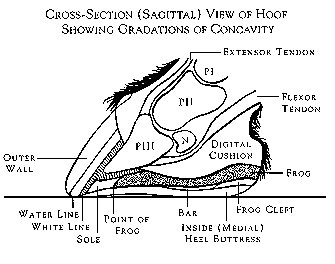
Treating Founder (Chronic Lamintis) without Horseshoes, Section 7
(Version with full-sized photos)
WHAT IS FOUNDER?...THE INSIDE VIEW
Definitions:
1. LAMINITIS is inflammation of the laminae ("white line") that leads to their destruction, due to their blood supply being shut off. The laminae are what suspend the coffin bone inside the hoof capsule. When they are destroyed, the coffin bone "founders" and rotates down inside the hoof capsule. (The hoof is much like a giant finger nail; the nail corresponds to the hoof wall, and the "quick" corresponds to a horse's laminae.)

(Cross-section of an ideal foot, from Jaime Jackson's "The Natural Horse")
2. ACUTE LAMINITIS is the first phase of laminitis, or first day of lameness. In this phase rehabilitation can be much faster.
3. FOUNDER, another term for CHRONIC LAMINITIS, results when laminitis is not properly treated in the acute phase, the critical first 24-30 hours. As laminae are destroyed by their blood supply being cut off, the coffin bone is no longer firmly attached to the hoof capsule. The coffin bone then ROTATES downward and back as the horse's weight goes down the coffin bone which is no longer well suspended..
| Conditions that predispose to founder: shoeing, high heels, contracted heels and inactivity.....which all lead to reduced hoof mechanism and long-term poor circulation. Poor circulation produces weaker laminae. A hoof in this already weakened state is less able to withstand laminitis triggers. Triggers that might only lead to transient inflammation and no rotation in a healthy foot can lead to inflammation and wound secretion, which exerts hydraulic force that pushes the white line apart. A healthy hoof with normal circulation will be better able to clear inflammation secretion from the hoof. A low-heeled hoof with the bottom of the coffin bone ground-parallel, which does not overload the toe laminae the way a high-heeled hoof does, is also better able to withstand these triggers without resulting in rotation. |
4. Hoof abscesses are a frequent result of laminitis. Laminar tissue dies as the result of circulation being cut off. When circulation returns, the body begins to remove damaged tissue through abscessing. Far from being a bad sign, abscessing actually is a sign of returning circulation and progress. It is part of the natural healing process, even though it is miserable to see the horse in pain from it before the abscesses burst through. When Max abscessed, his soles seemed bulged more before the abscesses broke through, which really was depressing--I thought it meant more rotation. As soon as the abscesses broke through, though, the swelling went down and his soles shrank back up and became more concave.
In a NORMAL FOOT:
1. The white line area is narrow, tight and solid all the way around. Viewed from the bottom of the foot, it is 1/8 of an inch wide, even at the toe.
2. The profile of the toe is a straight line, not a curved, duck-footed ("dished") line.
3. The distance from the toe to the tip of the frog is relatively short--things are compact from front to rear. If this specimen's toe was well rounded, the breakover would be backed up enough. As it is, it is a little too far forward in this photo.
4. Low heels, frog contact on the ground, short toes and functional hoof mechanism. One sign of having hoof mechanism is if you can see the heel bulbs spread slightly every time the horse puts weight down on the hoof.
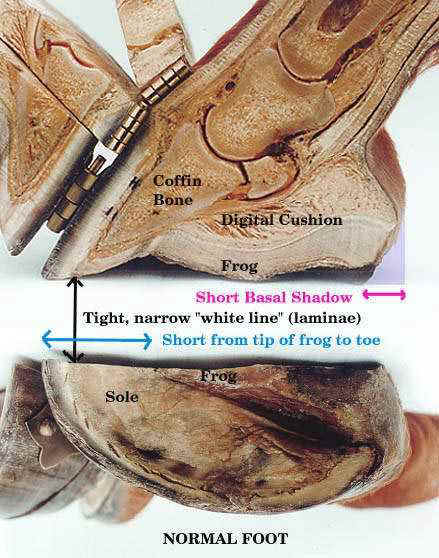
Normal Foot
(Specimen courtesy of David Frederick, DVM)
In case it LOOKS like the bottom of the coffin bone in the above "Normal Foot" is not really ground-parallel, please keep in mind that the coffin bone is vaulted; in a cross-section, the bottom of the bone will appear to be at a higher angle than the outside edges of the bone really are. Please study the coffin bone study below, and note that the bottom of the cross section is tilted close to 10 degrees to the ground plane:

In a FOUNDERED foot:
1. The white line area is stretched out wider at the toe.
2. The profile of the foot is a curved line ("dished")
3. The footprint is stretched forward into a more elongated oval shape.
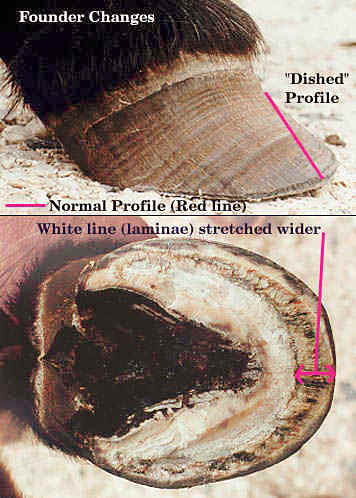
Foundered Foot
(Thanks to David Frederick, DVM, for permission to photograph this animal.)
4. As the toe stretches forward, because it is no longer firmly attached to the coffin bone, the distance between the tip of the frog and the toe stretches out proportionately.
5. As the coffin bone rotates downwards, it aligns the digital cushion behind because the whole hoof is tilted with high heels.
6. As the coffin bone rotates more, it gets less far ahead of the tip of the frog.
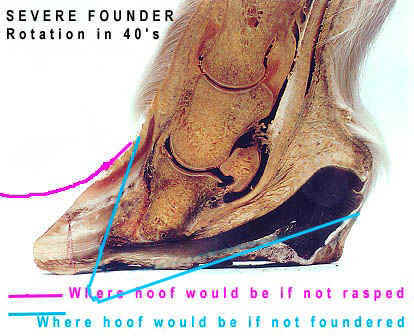
Above: Also note the remodeling of the coffin bone at the tip.
This pony mare died of colic in her 30's, had been on bute 15 years,
and had been severely foundered for years.
This photo shows how long-term rotation and
high heels result in the tip of the coffin bone eroding
For a real-life example of how just plugging in toe length and angle specs without taking rotation into account can damage a foot, here is deterioration over 2 years of doing just that:
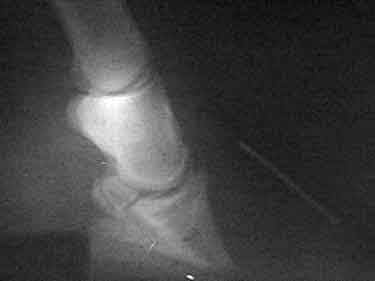
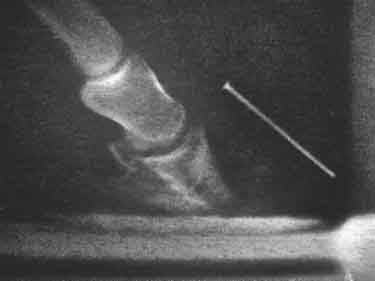
(When you just measure down the toe for a target toe length, and then adjust the heels from there to get your target toe angle--WITHOUT first backing up the toe--you over-shorten the bottom of the toe. This coffin bone was practically poking through the sole, and responded by remodeling into a ski-tip. This loss of coffin bone is a considerable setback. Scroll down to the bottom of this section to see where this kind of deterioration is headed.)
Another example of severe coffin bone deterioration due to long-term coffin bone tilting resulting from 5 years of high-heeled orthopedic shoeing:
A Progression from normal to extreme founder--scroll down!
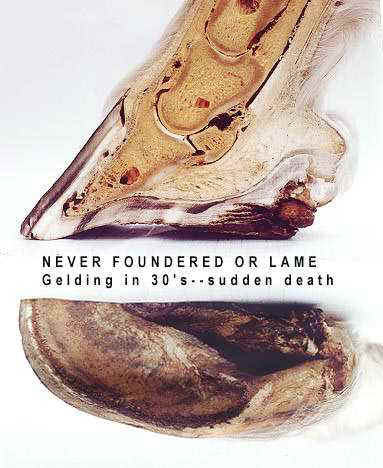
The above horse has never been foundered or lame.
Death in his thirties unrelated to any lameness.
Heels too high.
(Specimen courtesy of David Frederick, DVM)
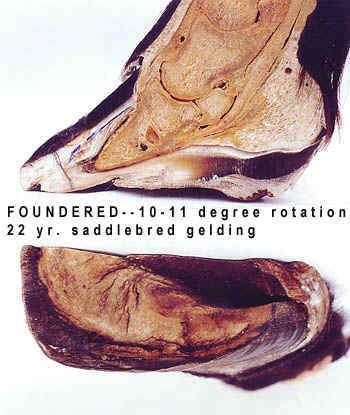
Serious Founder--10-11 degree rotation (above)
Heels too high!
Toes were squared to ease breakover, reduce leverage on toe.
(Specimen courtesy of David Frederick, DVM)
This horse could have been saved lowering the heels!

SEVERE Founder--(above)
These heels should be lowered--A LOT!!
Rotation in the 40's.
Toes squared and backed up, but still not enough.
X-rays helpful to see where to trim.
Lowering the heels enough would leave the sole turned
up like a ski at the toe until more toe grows down later.
(Specimen courtesy of David Frederick, DVM)
This photo shows how long-term rotation and
high heels result in the tip of the coffin bone eroding.
This horse could have been saved lowering the heels!
Note: The worse the founder,
1. the wider the white line
2. the more the tip of the coffin bone rotates downward--or worse yet, the entire bone sinks.
3. the more the toe stretches forward
4. If the laminae give way all the way around instead of mainly at the toe, the coffin bone may sink rather than just rotate.
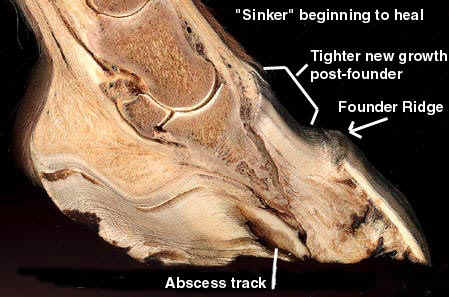
This "sinker" horse was actually beginning to heal despite bad shoeing.
Notice how the wall is growing down tighter to the bone above the founder ridge.
He was probably euthanised because of recurrent abscesses.
Patience, lowering the heels and backing up the toes could have saved him.
5. In the worst case scenario, the entire hoof capsule actually sloughs off. Horses have survived this with proper holistic care and natural living conditions. Sabine Kells tells me that the stump will harden off within hours, and that Dr. Strasser has just kept these horses unwrapped and on the firm, non-concussive ground of her hoof clinic--huge area of rubber mats. This is certainly a more workable approach, where the floor is kept clean, than in a stall where the horse will be stepping into his own wastes. New growth is rapid. She uses apple cider vinegar soaks, and sometimes propolis tincture, not bandaging and disinfectant chemicals. The horse does not use the foot for some time, but a new hoof does grow back. I also had a farrier in Illinois, Don Tritz, who brought a horse back who had sloughed off two front hooves, just keeping pads taped on the stumps until the walls grew back down. The heels had to be trimmed often, though, as they grow in first. He tells me it took close to a year for a new hoof to grow down completely at the toe, but that the horse did recover. However, most people elect euthanasia at this point, fearing the situation is truly hopeless. It really is not, but it's a rough situation.
When is it close to being hopeless?
Before you get your hopes up too high on a rehab, you really need to get some x-rays to see if there is significant bone loss. Long-term neglect and high heels can result in so much coffin bone loss that half of the coffin bone's front could be missing. Since the laminitic connection between the front of the coffin bone and the toe wall has been significantly reduced in these cases, the strength of the new connection between the coffin bone and the hoof wall will also be significantly lessened. This means that re-suspending the coffin bone will probably be less successful.
This cadaver hoof dissected at a Martha Olivo clinic shows significant bone loss. In one photo you can see where half of the hoof capsule is removed to show the position and shape of the bone. In this photo, you can also see the rasp handles that Martha is holding at approximately a 30 degree hairline slope. This gives an idea of just how much bone has eroded away from the bottom of the toe area. Also note enormously long, under-run heels. This poor horse's feet were from a carcass removal service.

After the bones were cleaned by boiling in a pressure cooker, you can see just how much bone loss there was:
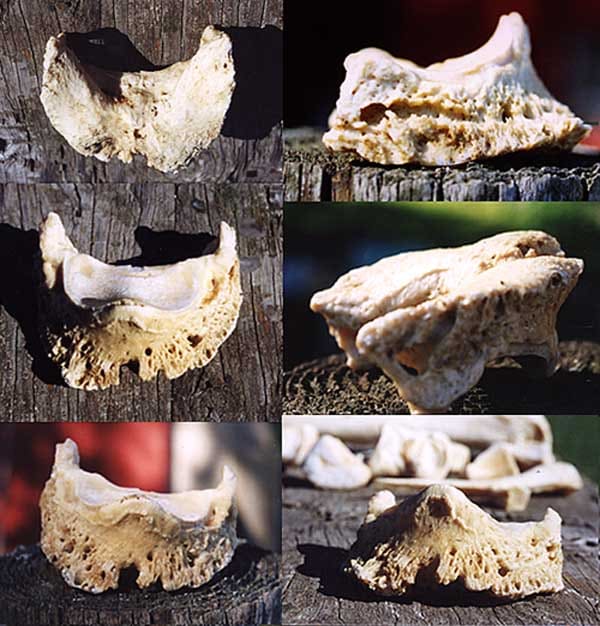
Compare these bones (above) with somewhat more normal bones below. The more normal bones have considerably more hairline slope because there is much less bone loss from the bottom of the toe area. They are also less eroded and pitted, and have more concavity. Since there is more bone left on the front of the coffin bone there is more area available for a stronger laminitic connection.

While a horse with considerable bone coffin bone loss may improve somewhat, I personally think it is unrealistic to expect a full return to soundness. When the coffin bone is still not that bad, though, healing is more feasible. In the specimen below, the horse was beginning to re-suspend a formerly sunken coffin bone despite poor shoeing. I can only speculate that the owners gave up on this horse due to abscessing--you can see an abscess track in this specimen. Because more of the front of the coffin bone was still intact, and the tip was not even yet remodeled into a 'ski tip' shape by long-term coffin bone tilting, this horse (below) would have had more of a chance to recover.

Coffin bone above was intact enough to
reattach; it was beginning to (note 'founder ridge.')
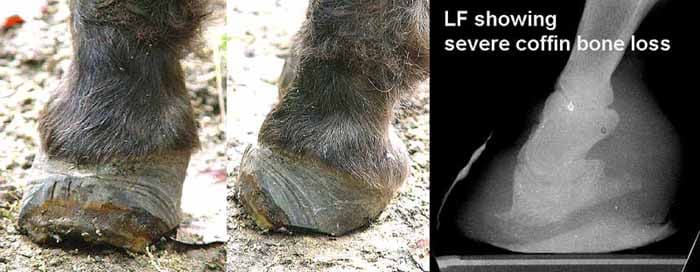

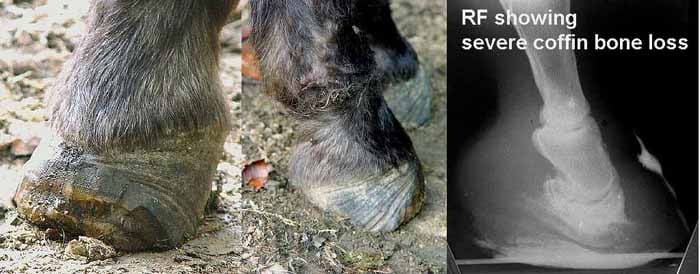

Rescue pony with years of founder; severe bone loss.
Not enough toe surface of coffin bone left to re-suspend it.
This pony was eventually put down. Photos, Anne "Tree" Coley.
Back to home page--Table of Contents
Article in sections with "thumbnail" photos for fastest downloads:
1 9 17
2 10 18
3 11 19
4 12 20
5 13 21
6 14 22
7 15 23
8 16 24
NAVICULAR
Article in sections with full-sized photos for print-outs:
1 9 17
2 10 18
3 11 19
4 12 20
5 13 21
6 14 22
7 15 23
8 16 24
NAVICULAR
To Strasser case studies--thumbnail photos for faster downloads
To Strasser case studies--large photos
Please sign my guest book! Photos of my pets My farm
Share Barefoot success stories on this page
Buy or sell used HORSE BOOTS Natural board Barn Listings
Click here to subscribe to naturalhorsetrim
(I moderate this listserv to weed out "fluff.")
Send Email to Gretchen Fathauer, or call (740) 674-4492
Copyright by Gretchen Fathauer, 2015. All rights reserved.